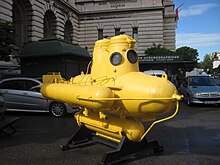Jacques Cousteau and British Army Major Percy Fawcett - Indiana Jones and Sherlock Homes
The real-life Percy Fawcett is said to have been one of the inspirations for the Indiana Jones character.
Percy Harrison Fawcett DSO (18 August 1867 – during or after 1925) was a British geographer, artillery officer, cartographer, archaeologist, and explorer of South America. Fawcett disappeared in 1925 (along with his eldest son, Jack, and one of Jack's friends, Raleigh Rimell) during an expedition to find "Z"—his name for an ancient lost city which he and others believed existed in the jungles of Brazil.[1]
Percy Fawcett was born on 18 August 1867 in Torquay, Devon, England, to Edward Boyd Fawcett and Myra Elizabeth (née MacDougall).[2] Fawcett received his early education at Newton Abbot Proprietary College, alongside the sportsman and journalist Bertram Fletcher Robinson. Fawcett's father, who had been born in India, was a Fellow of the Royal Geographical Society (RGS), while his elder brother, Edward Douglas Fawcett (1866–1960), was a mountain climber, an Eastern occultist, and the author of philosophical books and popular adventure novels.[3]
Fawcett attended the Royal Military Academy, Woolwich as a cadet, and was commissioned as a lieutenant of the Royal Artillery on 24 July 1886. This same year, Fawcett met his future wife, Nina Agnes Paterson, whom he married in 1901 and had two sons, Jack (1903-?1925) and Brian (1906–1984), and one daughter, Joan (1910–2005).[4] On 13 January 1896, he was appointed adjutant[5] of the 1st Cornwall (Duke of Cornwall's) Artillery Volunteers,[6] and was promoted to captain on 15 June 1897.[7] He later served in Hong Kong, Malta, and Trincomalee, Ceylon,.[8]
Fawcett joined the RGS in 1901, in order to study surveying and mapmaking. Later, he worked for the British Secret Service in North Africa while pursuing the surveyor's craft. He served for the War Office on Spike Island in County Cork from 1903 to 1906, where he was promoted to major on 11 January 1905.[9] He became friends with authors Sir Henry Rider Haggard and Sir Arthur Conan Doyle; the latter used Fawcett's Amazonian field reports as an inspiration for his novel The Lost World.
Colonel Percy Harrison Fawcett was a British archeologist and explorer. He was born in 1867 in Torquay, England. He is presumed to have died in 1925 when, along with his son and a family friend, he disappeared while on an expedition to find a legendary city lost in the uncharted regions of the Mato Grosso in Brazil.
At the time of his death, Col. Fawcett was an accomplished surveyor. He first traveled to South America in 1906 at the request of the Royal Geographical Society, in order to map the jungle areas bordering Brazil and Bolivia. Between the years 1906 and 1924 he made seven expeditions to this region.
Fawcett was a personal friend of the British authors H. Rider Haggard and Arthur Conan Doyle of Sherlock Holmes fame. It was said that it was Fawcett’s stories that were the inspiration for Doyle’s book “The Lost World”, and that his example as an adventurer and archaeologist later became the template for the screen character of Indiana Jones.
Fawcett had a passion for uncovering the mysteries of antiquity, and it was during his many expeditions to the jungle that he began to hear stories, told to him by the local Indians, of a lost city located somewhere in the Mato Grosso region of Brazil. The quest to discover this legendary city became the overwhelming obsession of his life. As he wrote in a letter to his son Brian:
“I expect the ruins to be monolithic in character, more ancient than the oldest Egyptian discoveries. Judging by inscriptions found in many parts of Brazil, the inhabitants used an alphabetical writing allied to many ancient European and Asian scripts. There are rumors, too, of a strange source of light in the buildings, a phenomenon that filled with terror the Indians who claimed to have seen it.”
“The central place I call “Z” — our main objective — is in a valley surmounted by lofty mountains. The valley is about ten miles wide, and the city is on an eminence in the middle of it, approached by a barrelled roadway of stone. The houses are low and windowless, and there is a pyramidal temple.”
 The lure of discovering this legendary city which he called “Z” became a siren song for Fawcett, as it had done for so many adventurers before him, as well as others who were drawn to that area after his death.
The lure of discovering this legendary city which he called “Z” became a siren song for Fawcett, as it had done for so many adventurers before him, as well as others who were drawn to that area after his death.
Yet this legendary city has remained tantalizingly out of reach, for there is no record that Fawcett, or anyone else, has ever returned to describe the place that has fired the imaginations of so many, as may be seen from the image shown here.
In 1925 Fawcett, together with his elder son Jack and his friend Raleigh Rimmell, set out to discover the lost city of gold. Fawcett always preferred to travel light, with companions who could be relied upon to negotiate the dangers that confronted them. Small groups of people were also less likely to attract the attention of hostile Indian tribes.
On May 29th, 1925, Fawcett telegraphed his wife saying that they were ready to enter unexplored territory in the region of the Upper Xingu, a tributary of the Amazon River. He said that they had sent the rest of the party back on account of the dangers posed by the local Indians, and that just the three of them would be going on. His message ended with the words; “You need have no fear of failure.”
This was the last that anyone heard of the expedition. The three men vanished into the jungle and were never heard from again.
No sooner had the group disappeared than rumors of their fate began to circulate. Some thought they had met their death at the hands of the Indians, while others were convinced they had died of disease or fallen prey to wild animals.
Percy Fawcett’s son Brian made two trips to the area to try to solve the mystery of their disappearance, but returned without success. But stories of a lost city of antiquity hidden deep in the jungles of the Mato Grosso continue to persist, and in the decades that have followed, more than a hundred people have lost their lives in their quest to find this lost city of Paititi.
Yet the haunting thought remains. Could Percy Fawcett actually have succeeded in finding his city of “Z” after all, but was prevented from leaving by the local Indians who guarded the site? Up to the time of her death, Fawcett’s wife remained convinced that her husband had achieved his goal, and had lived for many years in the city of his dreams.
Perhaps we shall never know, for the existence of this lost city has until now remained hidden in the mists that shroud the jungles of the Mato Grosso. These jungles guard their secrets well, for as the Oracle of Tolemac has written:
“Until that time when the world is ready to rediscover the lost science of Paititi their secrets will remain protected by the jungle, poisonous reptiles and hostile Indian tribes, who are the modern guardians of this ancient knowledge.”
The world might have forgotten about the hoary legends of Paititi if it had not been for the tales of a Swiss hotelier who visited South America in 1972, and met with a reclusive man with a sensational story to tell. The name of the Swiss writer was Erich von Däniken, and the man that he met was Juan Moricz.
At the time of their meeting Erich von Däniken was a successful author with a provocative theme. He had already published two books which had captured the popular imagination of the world and become instant best-sellers. These books were “Chariots of the Gods” and “Return to the Stars”.
While most scholars and scientists scorned his theories of “ancient astronauts”, von Däniken was nevertheless successful in drawing the attention of the world to ancient relics and ruins that defied the traditional explanation of the history of humanity. In his book entitled “The Gold of the Gods”, von Däniken described why he had arranged to meet with Moricz.
==================================================================================
I remember my father seeing his documentaries when I was nothing but a child and how admired I was for this guy bravery and for his amphibious car as well.... of course :) - In his tribute:
the old phrase has a literal meaning: We are all in the same boat."
Jacques-Yves Cousteau, AC (/kuːˈstoʊ/, also UK: /ˈkuːstoʊ/, French: [ʒak iv kusto]; 11 June 1910 – 25 June 1997)[1] was a French naval officer, explorer, conservationist, filmmaker, scientist, photographer, author and researcher who studied the sea and all forms of life in water. He co-developed the Aqua-Lung, pioneered marine conservation and was a member of the Académie Française.
Cousteau described his underwater world research in a series of books, perhaps the most successful being his first book, The Silent World: A Story of Undersea Discovery and Adventure, published in 1953. Cousteau also directed films, most notably The Silent World, the documentary adaptation of his book, which won a Palme d'or at the 1956 Cannes Film Festival. He remained the only person to win a Palme d'Or for a documentary film until Michael Moore won the award in 2004 for Fahrenheit 9/11.
Cousteau was born on 11 June 1910, in Saint-André-de-Cubzac, Gironde, France, to Daniel and Élisabeth Cousteau. He had one brother, Pierre-Antoine. Cousteau completed his preparatory studies at the Collège Stanislas in Paris. In 1930, he entered the École navale and graduated as a gunnery officer. However, an automobile accident, which broke both his arms, cut short his career in naval aviation. The accident forced Cousteau to change his plans to become a naval pilot, so he then indulged his passion for the ocean.[2]
In Toulon, where he was serving on the Condorcet, Cousteau carried out his first underwater experiments, thanks to his friend Philippe Tailliez who in 1936 lent him some Fernez underwater goggles, predecessors of modern swimming goggles.[1] Cousteau also belonged to the information service of the French Navy, and was sent on missions to Shanghai and Japan (1935–1938) and in the USSR (1939).[citation needed]
On 12 July 1937, he married Simone Melchior, his business partner,[3] with whom he had two sons, Jean-Michel (born 1938) and Philippe (1940–1979). His sons took part in the adventures of the Calypso. In 1991, one year after his wife Simone's death from cancer, he married Francine Triplet. They already had a daughter Diane Cousteau (born 1980) and a son, Pierre-Yves Cousteau (born 1982), born during Cousteau's marriage to his first wife.
Death and legacy
Jacques-Yves Cousteau died of a heart attack on 25 June 1997 in Paris, two weeks after his 87th birthday. He was buried in the family vault at Saint-André-de-Cubzac, his birthplace.[22] An homage was paid to him by the town by naming the street which runs out to the house of his birth "rue du Commandant Cousteau", where a commemorative plaque was placed.
Cousteau's legacy includes more than 120 television documentaries, more than 50 books, and an environmental protection foundation with 300,000 members.[1]
Cousteau liked to call himself an "oceanographic technician". He was, in reality, a sophisticated showman, teacher, and lover of nature. His work permitted many people to explore the resources of the oceans.
His work also created a new kind of scientific communication, criticized at the time by some academics. The so-called "divulgationism", a simple way of sharing scientific concepts, was soon employed in other disciplines and became one of the most important characteristics of modern television broadcasting.
Ironically, Cousteau's most lasting legacy may be a negative one. His Oceanographic Museum in Monaco, and perhaps even he himself,[23][24] has been identified as introducing the Caulerpa "Killer Algae," which is destroying much of the Mediterranean's ecosystem.
The Cousteau Society and its French counterpart, l'Équipe Cousteau, both of which Jacques-Yves Cousteau founded, are still active today. The Society is currently attempting to turn the original Calypso into a museum and it is raising funds to build a successor vessel, the Calypso II.
In his last years, after marrying again, Cousteau became involved in a legal battle with his son Jean-Michel over Jean-Michel licensing the Cousteau name for a South Pacific resort, resulting in Jean-Michel Cousteau being ordered by the court not to encourage confusion between his for-profit business and his father's non-profit endeavours.
In 2007, the International Watch Company introduced the IWC Aquatimer Chronograph "Cousteau Divers" Special Edition. The timepiece incorporated a sliver of wood from the interior of Cousteau's Calypso research vessel. Having developed the diver's watch, IWC offered support to The Cousteau Society. The proceeds from the timepieces' sales were partially donated to the non-profit organization involved in conservation of marine life and preservation of tropical coral reefs.[25]
The 1957 science-fiction book The Deep Range mentions a large research expedition submarine named Cousteau.
One episode of Elinor Wonders Why features him in a musical sequence where he is depicted as an otter.
Awards and honors
During his lifetime, Jacques-Yves Cousteau received these distinctions:
- Cross of War 1939–1945 (1945)
- National Geographic Society's Special Gold Medal in 1961[26]
- Commander of the Legion of Honour (1972)
- Officer of the Order of Maritime Merit (1980)
- Grand Cross of the National Order of Merit (1985)
- U.S. Presidential Medal of Freedom (1985)
- Induction into the Television Hall of Fame (1987)
- Commander of the Order of Arts and Letters
- Honorary Companion of the Order of Australia (26 January 1990)[27]
- Omicron Delta Kappa (1996)
Bibliography
- The Silent World (1953, with Frédéric Dumas)
- Captain Cousteaus Underwater Treasury (1959, with James Dugan)
- The Living Sea (1963, with James Dugan)
- World Without Sun (1965)
- The Undersea Discoveries of Jacques-Yves Cousteau (1970–1975, 8-volumes, with Philippe Diolé)
- The Shark: Splendid Savage of the Sea (1970)
- Diving for Sunken Treasure (1971)
- Life and Death in a Coral Sea (1971)
- The Whale: Mighty Monarch of the Sea (1972)
- Octopus and Squid: The Soft Intelligence (1973)
- Three Adventures: Galápagos, Titicaca, the Blue Holes (1973)
- Diving Companions: Sea Lion, Elephant Seal, Walrus (1974)
- Dolphins (1975)
- The Ocean World of Jacques Cousteau (1973–78, 21 volumes)
- Oasis in Space (vol 1)
- The Act of Life (vol 2)
- Quest for Food (vol 3)
- Window in the Sea (vol 4)
- The Art of Motion (vol 5)
- Attack and Defense (vol 6)
- Invisible Messages (vol 7)
- Instinct and Intelligence (vol 8)
- Pharaohs of the Sea (vol 9)
- Mammals in the Sea (vol 10)
- Provinces of the Sea (vol 11)
- Man Re-Enters Sea (vol 12)
- A Sea of Legends (vol 13)
- Adventure of Life (vol 14)
- Outer and Inner Space (vol 15)
- The Whitecaps (vol 16)
- Riches of the Sea (vol 17)
- Challenges of the Sea (vol 18)
- The Sea in Danger (vol 19)
- Guide to the Sea and Index (vol 20)
- Calypso (1978, vol 21)
- A Bill of Rights for Future Generations (1979)
- Life at the Bottom of the World (1980)
- The Cousteau United States Almanac of the Environment (1981, a.k.a. The Cousteau Almanac of the Environment: An Inventory of Life on a Water Planet)
- Jacques Cousteau's Calypso (1983, with Alexis Sivirine)
- Marine Life of the Caribbean (1984, with James Cribb and Thomas H. Suchanek)
- Jacques Cousteau's Amazon Journey (1984, with Mose Richards)
- Jacques Cousteau: The Ocean World (1985)
- The Whale (1987, with Philippe Diolé)
- Jacques Cousteau: Whales (1988, with Yves Paccalet)
- The Human, The Orchid and The Octopus (and Susan Schiefelbein, coauthor; Bloomsbury 2007)












Comments
Post a Comment